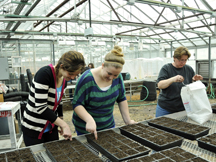Purdue Honors College class creates artistic way to look at soybeans' potential
March 4, 2013
 |
|
Freshmen
Robyn Wilson and Marissa Berns prepare soil for planting the project's
soybeans. (Purdue University photo/Fabian Winkler)
|
WEST LAFAYETTE, Ind. - As artists, Purdue University professors Shannon McMullen and Fabian Winkler aren't afraid to get their hands dirty. Neither are their students. Both spent hours digging holes for their upcoming public art installation beginning the week of March 18 outside Purdue University's Elliott Hall of Music.
McMullen and Winkler are working with the first class through Purdue's new Honors College to replicate a project that began when the couple made the move from Pittsburgh to Indiana.
"We saw cornfields and something else, cornfields and something else," said McMullen, an assistant professor of art and design, remembering the drive to their new Midwest home. "Neither one of us knew what the something else was, and that started the questioning process. That very simple question really began to get us here."
McMullen and Winkler are working with 17 Purdue freshmen to create the second National Security Garden public art instillation to celebrate that "something else:" soybeans. The project is a 16-by-12-foot planter box filled with rows of Edamame soybeans. A solar tower next to the box collects power for the magenta colored lights, comprised of red and blue LEDs, which refer to the light wavelengths that have the most influence on plant growth. When those lights turn on, the piece takes on a whole new look and meaning.
"It's really a magical moment," Winkler said "All of a sudden, this plant that looks so familiar to you during the daytime - you know all of these miles and miles of soybean fields in Indiana that you pass by - they get transformed into something different that's highly artificial, that's almost magical."
The lights also represent the tension between the technological world and the natural world.
"Our goal is to create a strong image that reflects a contemporary understanding of the complex relationships between technology and nature," McMullen said.
The first garden of this kind McMullen and Winkler built on their own as a result of interdisciplinary research initiated in their "Images of Nature" project, funded by the National Science Foundation. The project was supported by and displayed in the southern German city of Singen.
The class project demonstrates how artistic strategies can be used to spark a public conversation on the many problems facing food security and agriculture today.
"What we try to do is create a discourse around all the many different themes and topics that are captured in that one singular plant," said Winkler, an associate professor in visual and performing arts. "Not too many people know about all the intricate networks of public themes that this plant is involved in. We have issues of energy. We have issues of national security and plant science, crop science, genetically modified organisms and all of those issues are, for us, captured in that one plant."
The piece will be displayed outside of Elliott Hall until Mid-July. A gallery of the project's construction, from conception to creation, will complement the installation in the Stewart Center. The students also are organizing an April symposium of experts from all fields of study the piece addresses.
The students in the class, almost none of whom are art majors, will tend the plants and answer onlookers' questions about the piece. Since the project will be in such a high-traffic area, there is little doubt that people's curiosity will lead to conversation.
"I think it's important that it is outside the gallery," McMullen said. "It's outside the classroom and showing a connection between what art can do and the kind of ways art works and how it can affect everyday life."
The students' wide-ranging majors led to a diverse perspective being brought to the project, according to both the teachers and students.
"The fact that these issues are so universal and apply to so many people is what makes this important," said freshman prepharmacy major and Tennessee native Ariana Biglar. "This is not just an agriculture project. This is not just an art project. It applies to so much. I relate to it, and I'm a pharmacy person. We have engineering people, and they relate to it, too."
As do those students who are looking through the lens of social science.
"My studies of how states and their governments interact could easily include the ways they trade, specifically in foodstuffs," political science and history major Michael Brannigan said. "Why is the U.S. the biggest exporter? Why do we not export to certain states? Why do certain states reject aid or abuse that which they're given? These are the main topics I think about when confronted with food security. I think about the politics of food."
The class is hoping to take the project to a local middle or elementary school for permanent use.
In July 2011, Purdue's Board of Trustees approved the establishment of an Honors College to promote "diverse thinking and integrated solutions to society's complex problems." The college allows those from multiple disciplines to work together on a student-led method of learning. The freshmen in the fall of 2012 were the first group of students to be admitted to the college. Admittance is by invitation only and students must maintain a 3.6 GPA to remain in the program.
Writer: Morgan Stephens, 765-490-4855, MorganLStephens@gmail.com
Sources: Shannon McMullen, 765-494-0160, smcmullen@purdue.edu
Fabian Winkler, 765-494-1060, fwinkler@purdue.edu
Michael Brannigan, mbranni@purdue.edu
Related websited:
Electronic
and Time Based Art
Purdue Honors College Guiding Principles (pdf)
Note to Journalists: The class is tentatively scheduled to install the work outside Elliott Hall the week of March 18-24

